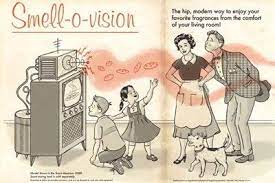The actual origin of April Fool’s Day is uncertain. Some speculate it dates back to 1582 when France switched from the Julian to the Gregorian calendar. If you’d somehow missed the memo, you’d be celebrating New Year’s Day on April 1st rather than January 1st, making you an “April Fool.” Some think it might be tied to the Roman holiday Hilaria, during which participants dressed in disguise and went around mocking people. At any rate, it has survived in different parts of Europe for centuries, and television companies have often used it to pull pranks on their viewers!

Smell-O-Vision
- In 1965, the British Broadcasting Company brought in a professor who claimed to have invented a device that allowed viewers to smell whatever was in the studio. The viewers at home needed no extra adapter on their TV; they could just breathe in whatever his Smell-O-Vision machine broadcasted.
- The professor even chopped strong onions and brewed coffee in the studio to demonstrate his machine. Several viewers called in to report they could indeed smell his coffee and onions!
- Interestingly, scent accompanying motion pictures wasn’t a new idea. In 1916, when films were still silent, the Family Theater in Forest City, Pennsylvania, fanned the scent of rose oil over an audience watching a newsreel of the Rose Bowl Game.
- In 1959, a special scent release system called “AromaRama” used a theater’s air conditioning system to spread smells that coincided with scenes in the film, Behind the Great Wall. And just a month later in 1960, another system called “Smell-O-Vision” piped scents directly to openings beneath the viewer’s chairs.
- Etc.
Color TV by Nylon Stocking
- In 1962, color television sets weren’t widespread–that came a few years later. But on April Fool’s Day in 1962, Sveriges Television in Sweden brought on an “expert” who used plenty of technical jargon to explain how a thin nylon stocking stretched over the screen would bend the light waves and produce colored moving pictures.
- It seems thousands of their viewers ruined a pair of stockings giving this hoax a try.
- Etc.
Spaghetti Tree
- However, the television hoax widely regarded as the best ever pulled off by a reputable broadcasting company was the BBC’s 1957 Panorama special on the Spaghetti Tree.
- At this point, spaghetti wasn’t all that common in Britain, and their viewers didn’t necessarily realize pasta is made from wheat flour and water. The BBC filmed a family harvesting the long spaghetti noodles from their trees, drying them in the sun, and celebrating the harvest with a traditional spaghetti dish. They filmed a Swiss family, explaining that raising spaghetti in Switzerland is a family business, unlike the commercial scale of Italy. They even mentioned that the long, even strands were the result of careful breeding of spaghetti trees.
- The usual news anchor, Richard Dimbleby, narrated the broadcast.
- Many Britons called in either to complain it wasn’t true or to ask for information about growing their own spaghetti trees!
While we may not know the origin, the holiday’s popularity for hundreds of years indicates people love having an excuse to get a laugh at their friends’ expense. While I personally think some pranks go too far to be funny, I think April Fool’s Day could be a good reminder to not take ourselves too seriously. Life happens, and sometimes you end up looking a little foolish. It’s okay to laugh about it.


One Reply to “April Fool’s Day on Television”
Comments are closed.